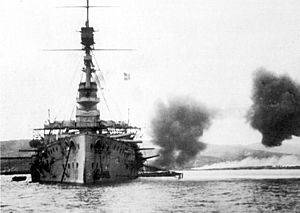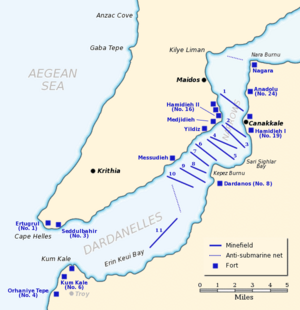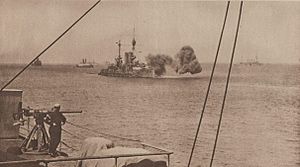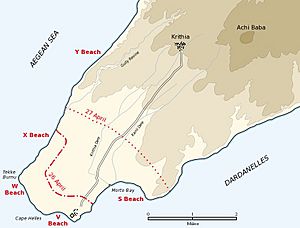HMS Cornwallis (1901) facts for kids

Cornwallis fires a broadside during the withdrawal from Suvla Bay in December 1915. Photo by Ernest Brooks
|
|
Quick facts for kids History |
|
|---|---|
| Name | HMS Cornwallis |
| Namesake | William Cornwallis |
| Builder | Thames Ironworks and Shipbuilding Company, Leamouth, London |
| Laid down | 19 July 1899 |
| Launched | 17 July 1901 |
| Completed | February 1904 |
| Commissioned | 9 February 1904 |
| Fate | Sunk by U-32, 9 January 1917 |
| General characteristics | |
| Class and type | Duncan-class pre-dreadnought battleship |
| Displacement | |
| Length | 432 ft (132 m) (loa) |
| Beam | 75 ft 6 in (23.01 m) |
| Draught | 25 ft 9 in (7.85 m) |
| Installed power |
|
| Propulsion |
|
| Speed | 19 knots (35 km/h; 22 mph) |
| Range | 6,070 nmi (11,240 km; 6,990 mi) at 10 knots (19 km/h; 12 mph) |
| Complement | 720 |
| Armament |
|
| Armour |
|
HMS Cornwallis was a powerful warship known as a pre-dreadnought battleship in the Royal Navy. She was built to compete with fast Russian battleships. Cornwallis and her sister ships were very quick for their time, reaching speeds of 19 knots (35 km/h; 22 mph). This made them the fastest battleships in the world when they were launched.
The ship was armed with four large 12-inch (305 mm) guns. These battleships were similar to other ships of their time but had slightly less armor. Cornwallis was built between 1899 and 1904.
After she was finished, Cornwallis served in different fleets around the world. She was in the Mediterranean Fleet, the Channel Fleet, and the Atlantic Fleet. When First World War started in 1914, she joined the Grand Fleet. In 1915, she was sent to the Dardanelles campaign to fight against the Ottoman Empire. Cornwallis fired the first shots of this important campaign. She supported ground troops and helped with evacuations. Sadly, on January 9, 1917, she was sunk by a German U-boat called U-32.
Contents
About HMS Cornwallis
Building a Powerful Ship
The Duncan-class battleships, including Cornwallis, were built because Russia had launched some fast battleships. The British wanted to have equally speedy ships. To make them fast without making them too big, the designers had to use thinner armor. This made them quicker but also less protected than some other battleships.
Cornwallis was 432 feet (132 m) long. She was 75 ft 6 in (23.01 m) wide and sat 25 ft 9 in (7.85 m) deep in the water. Her crew had 720 officers and sailors. The ship had two powerful engines that turned two propellers. Twenty-four boilers created the steam needed to power these engines. This allowed Cornwallis to reach a top speed of 19 knots (35 km/h; 22 mph). She could travel 6,070 nautical miles (11,240 km; 6,990 mi) at a slower speed of 10 knots (19 km/h; 12 mph).
Her main weapons were four 12-inch (305 mm) guns. These were placed in two turrets, one at the front and one at the back. She also had twelve 6-inch (152 mm) guns. These were for fighting smaller ships. For defense against torpedo boats, she carried smaller 12-pounder and 3-pounder guns. Cornwallis also had four 18-inch (457 mm) torpedo tubes hidden in her hull.
The ship's armor belt was 7 in (178 mm) thick. The gun turrets had 8 to 10 in (203 to 254 mm) of armor. The command center, called the conning tower, had 12 in (305 mm) thick sides. She also had two armored decks to protect against bombs from above.
Early Adventures at Sea
Cornwallis was named after William Cornwallis, a famous British admiral. Her construction started on July 19, 1899. She was launched into the water on July 17, 1901. Mrs. William L. Ainslie, whose husband was a director of the building company, officially named the ship. The launch was a big event, even though it was a quiet ceremony.
Work to finish the ship continued until February 1904. On February 9, 1904, Cornwallis officially joined the Royal Navy. She was sent to the Mediterranean Fleet. While there, she had a small collision with a Greek ship in September 1904. Luckily, she was not badly damaged.
In 1905, she moved to the Channel Fleet. Then, in 1907, she joined the Atlantic Fleet. She had some repairs in Gibraltar in 1908. In 1909, Cornwallis returned to the Mediterranean Fleet. By 1912, she was part of the Home Fleet in Gibraltar.
World War I: A New Role
When World War I began in August 1914, Cornwallis was assigned to the Grand Fleet. Her job was to patrol the seas and help block Germany. She worked with other ships to keep watch.
In November 1914, Cornwallis was temporarily moved to the Channel Fleet. This was to help protect against German ships. She was based in Portland and Dover. Later, in December, she was sent to patrol off the coast of Ireland. She stayed there until January 1915.
Fighting at the Dardanelles
In January 1915, Cornwallis received new orders. She was to go to the Dardanelles in Turkey. This was for a big campaign against the Ottoman Empire. She arrived on February 13, 1915.
On February 19, Cornwallis fired the first shots of the Dardanelles campaign. She attacked Ottoman coastal defenses. She helped other ships by spotting targets for them. Later that day, she joined other battleships to attack a fort at Kumkale. The Ottoman guns eventually fired back, but Cornwallis was not hit.
A few days later, on February 25, Cornwallis was part of another attack. She and other ships attacked the defenses at close range. They tried to clear the way for minesweepers. The attacks continued over the next few weeks. Cornwallis helped destroy Ottoman guns on shore.
On March 4, Cornwallis supported a landing party of Royal Marines. The marines went ashore to destroy Ottoman guns. Cornwallis shelled the fort at Kumkale. However, the Ottoman resistance was too strong, and the marines had to pull back.
The naval attacks did not fully destroy the Ottoman defenses. So, the British and French decided to land ground troops. This was to secure the land and allow ships to pass.
On April 25, Cornwallis helped with the Landing at Cape Helles. She covered the landing sites, especially V Beach. She carried soldiers and then transferred them to smaller boats. Cornwallis fired heavily on the hills above V Beach. This helped the British troops fight their way off the beach.
For the next month, Cornwallis and other battleships supported the troops on shore. On May 13, while protecting the right flank, her sister ship Goliath was sunk by an Ottoman destroyer. Cornwallis helped rescue survivors.
In December, Cornwallis was at Suvla Bay. She helped with the evacuation of troops from the area. On December 20, she fired many shells to destroy equipment that could not be taken away. She was the last large warship to leave Suvla Bay.
Final Missions and Sinking
After the Dardanelles campaign, Cornwallis was sent to the Suez Canal Patrol in January 1916. She also served on the East Indies Station, escorting convoys in the Indian Ocean. In March 1916, she returned to the Mediterranean Sea.
On January 9, 1917, a German U-boat called U-32 attacked Cornwallis. She was hit by a torpedo on her right side. Water flooded some parts of the ship, and she tilted. The crew tried to fix the tilt. But the ship could not move, making her an easy target.
The U-boat fired another torpedo. About 75 minutes after the first hit, the second torpedo struck Cornwallis again on her right side. The ship quickly rolled over. Fifteen men were killed by the explosions. However, the ship stayed afloat long enough for the rest of the crew to get off safely. Cornwallis sank about 30 minutes after the second torpedo hit.







